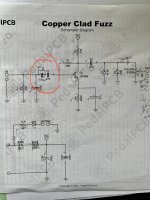Arossignol
New member
Hi all! I built the Copper Clad Fuzz (Mythos Golden Fleece) and really enjoyed it, but it had a bit too much bass for my liking. So I put it on a breadboard and experimented with it until I found something I really like.
I put a “low cut filter” (I put those in quotes because I’m not sure if it’s the real term, or if it’s just a high pass filter) right before C1 (on attached pic). It’s a 330pf cap on legs 1 & 3 of a 250k audio pot.
What I’d like to know is how to implement it in an actual build. My first thought is to build it on the PPCB board and wire in the pot for this mod in between C4 and C1, then cut the trace in between them. Is this a good idea? Are there better ways of doing it?
Thanks for your input!
I put a “low cut filter” (I put those in quotes because I’m not sure if it’s the real term, or if it’s just a high pass filter) right before C1 (on attached pic). It’s a 330pf cap on legs 1 & 3 of a 250k audio pot.
What I’d like to know is how to implement it in an actual build. My first thought is to build it on the PPCB board and wire in the pot for this mod in between C4 and C1, then cut the trace in between them. Is this a good idea? Are there better ways of doing it?
Thanks for your input!



